Mould is a pervasive and harmful living organism that can penetrate almost any surface or space — especially spaces that are damp or have poor ventilation. There are thousands of different species of mould that occur in our natural and built environments. Despite its prevalence, some types of mould can have severe effects on our health.
Keep reading to learn about mould in your strata property, how it may be caused, how to identify it and most importantly, how to prevent it from occurring in the first place.
Mould thrives in poorly ventilated wet or damp environments. There can be many reasons for outbreaks of mould in your strata property, ranging from strata property water damage caused by severe defects to personal practices that can easily be changed. Some of the more common causes include:
Before renewing your agreement, take a moment to compare your options. Our quick and easy form can be completed in less than 30 seconds.
With more than 150 different types of mould found in Australian properties, it can take many different forms and grow in hard-to-reach places, making it challenging to identify and ascertain how dangerous it is.
Mould can appear as a stain or discolouration, a collection of oddly shaped or slimy spots or fuzzy appearances on a building surface. The presence of a strange, musty smell could also be a sign of mould.
When you notice mould in your strata property, it’s essential to identify which mould you are dealing with and how toxic it is. Some common types include:
Type of mould |
What it looks like |
Example |
Where it thrives |
| Acremonium | Initially a small, moist type of mould, acremonium can become fine and powdery. It can seem pink, orange, white or grey | 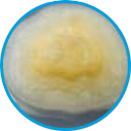 |
In areas with lots of condensation, including humidifiers, window sealants and drain pans |
| Alternaria | Velvet-like in texture, with fine green or brown hairs. This is the most common type of household mould | 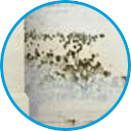 |
Anywhere with dampness or water damage. |
| Aspergillus | Flask-shaped spores that can form thick layers. There are more than 185 species within this type of mould, and they appear in a range of colour |  |
It is commonly found both indoors and outdoors |
| Aureobasidium | Pink, brown or black mould that darkens with age | 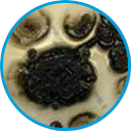 |
Behind painted, wooden or wallpapered surfaces |
| Chaetomium | White, grey or brown mould that darkens to black over time. It is cotton-like in texture and may produce a musty smell | 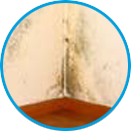 |
In damp, leaking or water-damaged areas within buildings and homes |
| Cladosporium | A mould with a texture similar to suede that is olive green or brown | 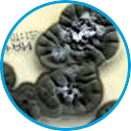 |
On materials like fabrics, upholsteries and carpets, inside cupboards and under floorboards |
| Fusarium | A pink, reddish or white mould | 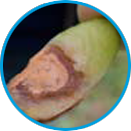 |
In buildings with water damage, especially on carpets, wallpaper and fabrics |
| Mucor | Thick white or grey patches of mould that spread quickly |  |
On damp carpets and areas with condensation, such as near air conditioning units and ducting |
| Penicillin | Velvety-textured blue or green mould | 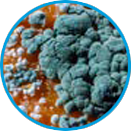 |
In water-damaged areas and items such as carpets, ducting and mattresses |
| Stachybotrys | Slimy-textured black or dark green mould | 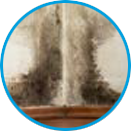 |
In areas that are damp, wet or high in humidity over a long time |
| Trichoderma | White mould with green patches that is woolly in texture | 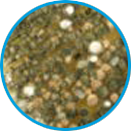 |
On wet surfaces within buildings, including on wallpapers, carpets and damp fabrics |
| Ulocladium | Black in colour | 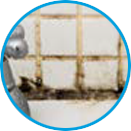 |
In wet areas, or areas with extreme water damage |
Mould needs moisture and nutrients to grow, and the best way to tackle it is to prevent outbreaks from occurring in the first place. The good news is, controlling both these factors is critical to minimise the likelihood of a mould outbreak in your strata property.
These ten tips may help you control and reduce outbreaks of mould in your strata property:

Preventing excess water from overflowing gutters and pipes may minimise the likelihood of mould outbreaks in areas where there’s little or no sunshine to dry the surface.

Mould doesn’t grow in UV light, so limit the use of curtains and blinds in common areas or open the windows frequently to enjoy the sunshine and stop the mould from taking over.

Regular cleaning of common areas, particularly vacuuming carpet areas, will help reduce airborne dust and mould spores. While there is a wide range of vacuum models in market, do look out for one with a HEPA filtration trap. This helps to capture the dirt you can’t see, rather than sending allergens back into the air.

A good air conditioner is a worthwhile alternative to a dehumidifier in the fight against mould. A hybrid split system or reverse cycle air conditioner can draw air from the outside and circulate it inside, reducing the humidity and excess moisture without affecting the temperature.

If your property’s hidden-away areas are prone to mould outbreaks, invest in high-quality mould resistant paint. They contain a chemical called fungicide that is designed to cope against mildew commonly found on the walls and ceilings of bathrooms.

Promptly repair leaking bridging piping. A sure sign of this is if you notice the plaster or paint bubbling or if the carpets are wet. Routine property or home maintenance can help identify the problem early on.

Strata properties built with brick or stone can be quite porous. If these materials are exposed to excess water, the masonry will absorb the water in the wall. The water carries salts that eventually move through the wall and evaporate onto the surface, which creates a moisture stain. If this is the case, you may need to install a new membrane, mould-resistant plasterboard or insulation.

Mould strives in damp environments, especially where moisture can’t easily escape. To avoid humidity in closed areas and thereby reduce outbreaks of mould in your strata property, remember to turn on the exhaust fans when bathing, showering, cooking or doing laundry. Also, try to keep common area windows open for ventilation whenever possible.

While indoor plants can beautify common property or your home, they can also provide the perfect breeding ground for mould in your strata property. To stop this from happening, don’t let water stagnate in drip trays. Add a dash of natural antifungal substance that can hinder mould growth in the plant soil. Of equal importance are outdoor window or planter boxes that may not feature adequate drainage. They can deteriorate and allow water to permeate the adjoining walls and structures. This water may even seep into internal walls, causing large-scale water damage.

If some rooms in your strata property are more prone to mould than others, you could consider setting up and running a dehumidifier in them. Keeping the humidity of a room under 40% is ideal for preventing mould, and a dehumidifier may help you achieve this.
Before renewing your agreement, take a moment to compare your options. Our quick and easy form can be completed in less than 30 seconds.
When it comes to managing a strata property, there are various compliance or legislative requirements that are needed to protect owners and residents. Also, when the situation allows, you don’t want to miss out on the chance of an insurance claim. Ask about our by-laws, Community Health & Safety and related services to ensure your protection. You can also download our FREE Community Living guide series on defects by clicking here.

Download our FREE community living guide on committee management.

From the latest state legislation news to easy-to-read factsheets and guides, we’ll keep you informed.

Find out more about our services today.
This article is edited by Lauren Shaw Regional General Manager and Licensee-in-Charge on August 2024.